The Covid era has changed our attitudes to what is possible regarding where, when and how we work. Before 2020, only 18% of employees carried out any work remotely; three years later, research from Forbes puts that figure at over 28%. The experience of a flexible approach to work during the pandemic has shifted employee expectations of traditional office work. As a result, the new business-as-usual often includes an element of hybrid and flexible work that wasn’t present previously. This change presents employers with new challenges and opportunities regarding the future of the workplace.
Despite the hype and concerns around remote work, most working time is still spent in the office. However, with 98% of workers keen to work remotely at least some of the time, the traditional 5-day week in the office looks to be a thing of the past.
Of course, the office is just one of many working environments. Many roles can’t be conducted remotely, and they also face pressures from evolving employee expectations regarding flexible working. The legislation surrounding flexible working in the UK and the successful trials of shorter, 4-day working weeks are just two demonstrations of a broader shift in priorities from presenteeism to productivity.
Employees have undoubtedly benefited from a more flexible approach to work since the advent of Covid-19. The need for remote work showcased a more flexible approach that proved productive, whilst employees saw benefits in improved work-life balance and reduced costs.
A 2023 Greenhouse survey of over 800 UK employees found 77% of employees would actively look for a new job or be willing to consider one if their company’s flexible work policies were to be reversed. Businesses that aren’t willing to adapt can also struggle to attract top talent, as more than 40% of candidates will not apply for a role that does not offer their preferred working model.
 Hybrid remains the preferred working for almost half (47%) of all workers, while more than 11% prefer a fully remote model, suggesting that employees want a flexible mix of in-person and remote work. The shift to hybrid and remote work also facilitates asynchronous work, or work not carried out during set company hours. This approach can be powerful in output-driven roles and allows for fewer interruptions and more opportunities for focus. However, this also poses challenges in team management and how those working asynchronously can continue to collaborate and feel included.
Hybrid remains the preferred working for almost half (47%) of all workers, while more than 11% prefer a fully remote model, suggesting that employees want a flexible mix of in-person and remote work. The shift to hybrid and remote work also facilitates asynchronous work, or work not carried out during set company hours. This approach can be powerful in output-driven roles and allows for fewer interruptions and more opportunities for focus. However, this also poses challenges in team management and how those working asynchronously can continue to collaborate and feel included.
Those in roles unable to be carried out remotely aren’t left out of the flexible working trend, with flexi-time and condensed hours also offering improvements in work-life balance. In the UK, the Flexible Working Act is becoming law, allowing employees to make flexible working requests from day one.
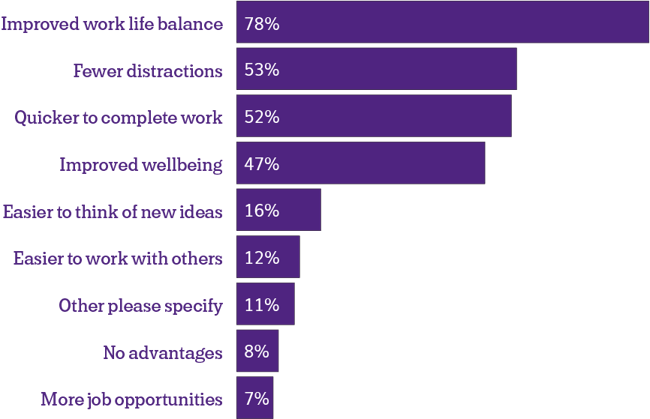 Source: ONS survey 2022
Source: ONS survey 2022
In 2022 a raft of companies introduced a 4-day week for full-time employees, with many making this a permanent move. Proponents of the scheme argue that the reduction in hours is made up by a leap in productivity, offering employees a better work-life balance with little impact on the employer’s bottom line. Naturally, this offer is compelling to candidates and almost 70% of workers say they would be more likely to apply, or only apply to, a job that offers it.
 In the UK, 92% of companies involved in a 6-month trial of the 4-day week decided to make changes permanent. Meanwhile, in Belgium, there is now legislation in place that allows workers to choose to condense hours into four days rather than reduce total hours. The UK trial results showed that employers also saw significant benefits, maintaining revenue and achieving a 65% reduction in sick days and a 57% reduction in the likelihood of quitting.
In the UK, 92% of companies involved in a 6-month trial of the 4-day week decided to make changes permanent. Meanwhile, in Belgium, there is now legislation in place that allows workers to choose to condense hours into four days rather than reduce total hours. The UK trial results showed that employers also saw significant benefits, maintaining revenue and achieving a 65% reduction in sick days and a 57% reduction in the likelihood of quitting.
Many companies that aren’t yet fully able to adopt the 4-day model are making steps in this direction. The 9-day fortnight, where employees work 9 out of every 10 working days, is one way this happens. There is also anecdotal evidence that some employees, particularly caregivers, prefer spreading the shorter hours across five days rather than being confined to 4 days.
So much so that we use these insights to inform our own business practices, as well as those of our clients. We operate a hybrid working model and offer an early finish on Fridays. In light of this new research, we will now bring this finish forward to 12pm and operate a 4-and-a-half-day week for a trial period.
This reduction in hours aligns with how we prioritise well-being at Talent Insight Group, providing access to life coaching and counselling sessions alongside other benefits.
Creating a sense of team spirit is critical in any business. Hybrid and remote working can make this challenging, but simple initiatives such as visibility of office days can help to build this community feel. This relational aspect is vital for many employees, particularly younger workers who may have started their careers during COVID-19 and feel they have missed out on the social aspects of work. While 31% of remote workers had no issues working remotely, 24% reported struggling with loneliness, and 51% felt disconnected from their co-workers, showing there is still much to be done to improve connection and collaboration.
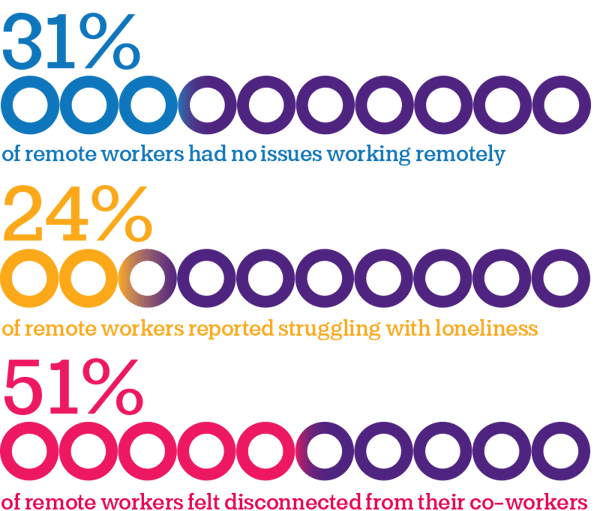
Want to read this offline or share with a colleague? Simply fill in some details to download a copy.
Employers can make the office a more appealing space by tackling common frustrations and reshaping their office space to fit the needs of their workforce.
This is especially prevalent when it comes to meeting spaces and the need for quiet areas for focused work. A 2022 survey found that spaces for creative group work and focused individual work significantly impact space effectiveness and experience, noting that a new mix of workspaces would increase time spent in the office.
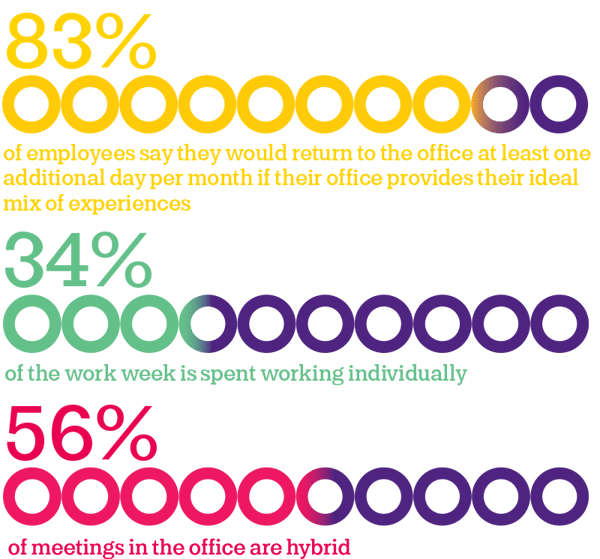
One of the significant advantages of remote working is the lack of commute. Employees are now looking for employers with spaces and locations that minimise this friction, from access to public transport and parking to facilities that allow for a green commute, such as bike storage and on-site showers.
Office space is a significant overhead, and changing attitudes to the workplace means that now is a good time to consider how to best use this resource. A 2023 report by The Conference Board found that the highly publicised return to office mandates from the likes of Amazon and Disney were the exception, with only 4% of CEOs citing reducing hybrid and remote working practices as a focus for 2023. However, a recent CBRE survey found less than 10% of office space remains the same post-pandemic, and while 52 percent of businesses will reduce space; 39 percent will expand.
As remote and flexible working rises, companies are reconsidering office space. Does it need to be in an expensive city? Are local offices required, or can the business operate from a central location?
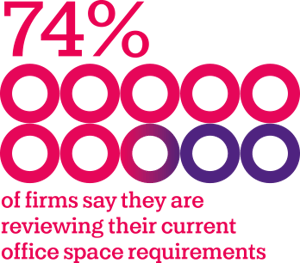
There have certainly been businesses that have embraced these changes. 74% of firms say they are reviewing their current office space requirements, particularly those in the insurance, finance and banking sectors.
Consolidation of office space also opens up options to move the head office away from the capital, bringing benefits such as lower costs and the opportunity to compete in a less saturated market for talent by moving away from competitors.
Even before the pandemic, businesses were taking advantage of these opportunities. Channel 4 moved to Leeds. HSBC’s UK headquarters are in Birmingham. Other companies are following suit. As the number of people leaving London reached a record high in 2019, companies relocating outside the capital have an even bigger talent pool. Add to that remote working options; location has become increasingly less important.
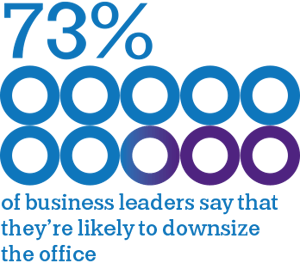
While businesses with multiple offices may look at consolidation, many are finding a hybrid approach can allow them to downsize and save on these costly overheads.
Alongside the move of HSBCs UK headquarters to Birmingham, the bank more recently announced plans to downsize its current world headquarters on Canary Wharf by moving to smaller premises in the City of London when the lease expires in 2027.
This follows a statement outlining the intention to reduce office space by 40% back in 2021. This move echos a wider trend to reduce office space. In November 2022, the Financial Times reported England’s stock of office space was falling at the fastest rate in 20 years, showing the impact of this cutback on office space and subsequent slowdown in construction.
While employers will be familiar with the image of underutilised space, businesses must consider peak time use to manage downsizing effectively.
Businesses should also consider any requirement for all-hands sessions and whether it is worth investing in additional flexible space to meet this need if this is rare. This data will allow you to calculate the workspace you need and take advantage of the cost savings a smaller office could bring.
With all the data around relocation, office closures and remote working, it may seem that the traditional office is a thing of the past, and future-thinking businesses will no longer require one. But with many employees operating on a hybrid basis, keeping your existing office may make sense. Indeed some firms are pushing a total back-to-office approach, making office space an essential requirement. A recent report from the US Bureau of Labor Statistics found that only 5.5% of businesses cut office space during the pandemic, and only 4% of companies expect to reduce office space in the next 12 months.
Of course, maintaining the same office space does not mean you need to use it the same way. A flexible workspace can allow businesses to adapt to hybrid working and give freedom to change working practices as required.
Businesses keen to attract staff back into an office environment must re-examine the purpose of the office, including what employee expectations of office work are, how office space can be used effectively to enhance creativity and productivity, and how employers can ensure the office is an attractive and valuable place for employees to spend their working time.

A Work Trend Index survey by Edelman Data x Intelligence in January 2021 found that "66% of leaders say their company is planning a space redesign for hybrid work."
In a recent survey, just 43% of surveyed workplaces offer effective spaces and great workplace experiences; one-third have neither. Office workers in all nine countries surveyed spend an average of 42% of their time working with others, consisting of virtual (14%) and in-person (28%) work.
The shift to hybrid working prompts many to re-think the purpose of office space and what is needed from office interactions. Employees seek more space for collaborative work and creative thinking while also requiring quiet spaces for distraction-free working, and the classic open-plan layout can make this problematic.
Co-working spaces suffered during Covid, but the market has experienced a resurgence in recent times and looks set to grow to meet the demand for more flexible workspaces. According to Mordor Intelligence, the UK co-working office space market is set to grow by 8% by 2027.

Source: Gitnux
Although 42% of coworking space members worldwide are freelancers, many large firms also take advantage of this flexibility. For smaller operations, co-working spaces can be used as a fully serviced regular office location, and for many larger businesses, they provide a helpful extension to existing spaces.
There’s no question that remote working increased significantly as a result of the pandemic. Data from the ONS shows that almost half of all UK employees were working from home at the peak of the first UK lockdown between 23rd March and 5th April.
Many of these businesses have continued to offer an element of remote working through a hybrid model ever since. However, there are several high-profile examples of remote-first, or fully remote businesses, most often in the technology business.
Examples of remote businesses include:




Fully remote operations offer even more benefits in terms of cost savings. Still, it makes it even more critical to invest in the business culture and the skills of remote first training and management functions.
Want to read this offline or share with a colleague? Simply fill in some details to download a copy.
When deciding the right option for your business, there are many factors you will need to consider. Here we outline some of the major areas to help guide you through this process.
Covering set opening hours can make flexibility difficult for employees in roles requiring on-site attendance. However, adaptions can be made to offer shift patterns that allow parents to balance work with childcare responsibilities or by reworking rotas to allow for condensed hours or shorter working weeks. Research shows that providing this flexibility is rewarded by a boost in productivity. However, this may need to be balanced against sufficient cover to maintain full operating hours in some areas.
Remote and hybrid teams operate differently from in-person. Incidental conversations are reduced, and shadowing an existing employee is more complicated. Managers can no longer observe an employee at work, only on the outputs of their work. These changes reduce the presenteeism culture and change the manager's role. Surveys show managers need more confidence in managing remote and hybrid teams, so additional training and support may be required to ensure they can do so effectively. This new way of working also impacts training, especially for new employees. Traditional training and onboarding will need to be reviewed and reworked to suit this new mode of working.

With many people working from a kitchen or dining room table or even a sofa, employers must consider ergonomics and safe working practices. In offices, companies ensure staff have separate screens, keyboards and office chairs, but those at home may be working on laptops from a rigid chair. In 2021, the Royal Society for Public Health reported that 26% of homeworkers were working from either a sofa or a bedroom, demonstrating the squeeze on living space. The same health and safety requirements apply whether the worker is at home or office-based, so companies must ensure they meet their obligations. HSE has more information and advice.
If you have staff from lower socio-economic groups working from home, they are less likely to have a dedicated office space. They may also need faster internet connections and more generous phone contracts. Analysis from the ONS found that higher-paid employees were more likely to be able to work from home, possibly due to better connectivity.
Other research showed that 29% of employees struggle with technology issues. Research from Cisco found that, alongside ensuring effective communication, 79% of employees think every staff member should have access to similar technology to their office set-up. Businesses must ensure all employees have access to technology and that lower-paid employees are not disadvantaged.


Another critical area to consider is data security. There has been a significant increase in cyber attacks since the pandemic, and employees may also be putting data at risk: recent data found that 7% of people had uploaded sensitive corporate data to personal cloud accounts. Companies must ensure that their policies are up to date for a new era of remote working and that employees have the training and tools to keep corporate data safe.
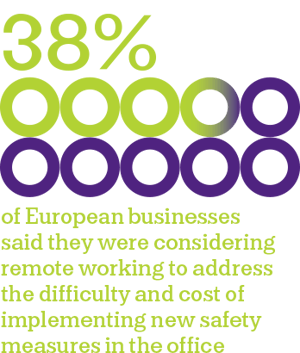
The issues around security become even more pressing for certain industries. In October 2020, the FCA confirmed that banks must apply the same levels of conduct and surveillance whether workers are remote or in the office. At the same time, data rules around areas like inside information may change. Companies must be alert to industry standards when planning remote, flexible or hybrid working and ensure that these rules are applied consistently, regardless of how or where employees work.
Of course, alongside industry standards, there are government standards which must be met. Since the arrival of the coronavirus, the UK government has issued 14 new guides for different types of businesses to ensure they can operate safely.
Research found that these new standards could be driving remote working. 38% of European businesses said they were considering remote working to address the difficulty and cost of implementing new safety measures in the office.
A change in working location undoubtedly brings about a culture change. As we adjust to working from home, there have been some startling differences between our expectations and reality.
If we envisage more free time and commuting time spent relaxing, the reality may be different. While 23% say they are working fewer hours, other reports suggested we are working longer hours instead, switching the commute for the desk: depending on which research you read, spending 2 hours, 3 hours or even 4 hours longer at work each week.
These longer hours have been cited as a factor in mental health issues, with 49% more staff reporting mental distress than in 2017-2019.
In particular, staying connected can be a challenge. Research found that:
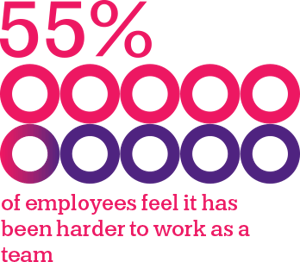

These findings may account for the number of meetings, which has risen from 5.9 per day to 6.9, although the average length of meetings has fallen. Looking for new ways to maintain connections is important while employees adjust to a new way of working.
It’s also important that staff feel supported throughout this time.
New research found:
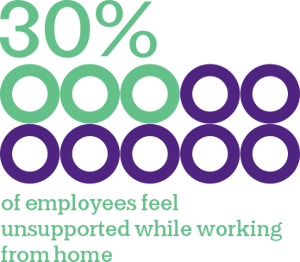
It’s, therefore, essential that companies adapt their processes to enable everyone to benefit from the opportunities opened up by working remotely.
While all this data may seem negative, it highlights the challenges that businesses face in changing to a new working model. One key figure to take away: despite all the challenges outlined above, 64% of people said they felt that remote working positively impacted workplace culture.
At a time when the focus is on diversity and inclusion, businesses must ensure that changes to how and where we work don’t negatively impact these initiatives.
The first conversations often concerned how extroverts and introverts may find the “new normal”. Initial comments suggested that extroverts may find the change more difficult and feel isolated from colleagues. This can be true, and managers must ensure the culture supports all individuals and build connections to keep people involved.
However, one less frequently discussed area is the impact on introverts, especially as we move to more online communications. In the fast-moving world of Zoom meetings and online chat, extroverts can unknowingly dominate conversations, and introverts can find it difficult to make their voice heard.
One company doing excellent work in this area is Ultranauts, who have changed their approach to internal communications by:
While this approach may need to be adapted to each business, it’s a fantastic model for looking at internal communications differently.
When discussing inclusion, it’s also essential to look at the impact of remote working on minority ethnic groups.
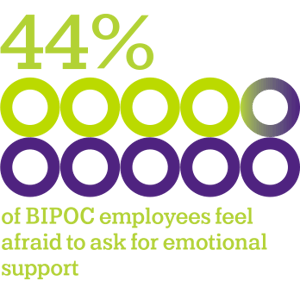
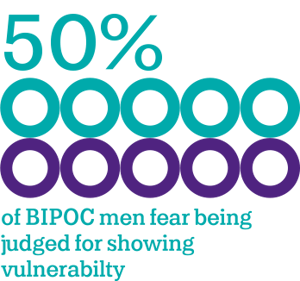

Businesses must create an inclusive culture where employees feel safe to raise issues and ask for the support they need.
Studies show that those from a minority background are less likely to want to return to the office as they can work in an environment where they feel more comfortable. Written forms of communication can make it easier for minority voices to be heard, and it’s also reported that minority employees experience fewer micro-aggressions when working remotely.
When considering if remote working has had a positive or negative effect on gender equality, the picture is complicated. Women, in general, report feeling less happy and motivated at home than men. One major factor in this is the impact of caring responsibilities, especially for those with young children.
Research shows that women continue to take on more of the childcare, with data from 2019 revealing 28.5% of women with children aged 14 and under had cut their working hours due to childcare. The figure is just 4.8% for men.
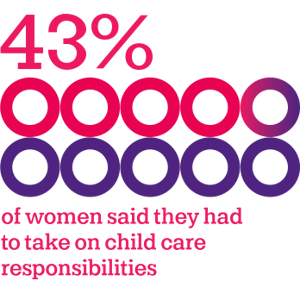

In addition, women are less likely to have a dedicated, separate workspace in the home: research found that almost 50% of men do vs a third of women. This lack of privacy and separation of work and home could impact the long-term viability of working from home.
However, there have been positive outcomes of changing working spaces and attitudes. What is deemed “professional” may be re-evaluated as the barriers between home and work blur and as we see more and more TV interviews and Zoom meetings gate-crashed by children and pets. This may allow all workers to blend work and home life more successfully.
Some women say that working from home gives them more flexibility. And research by Zurich UK found that companies offering flexible working options could see a 20% increase in female applicants for management roles and an overall 16% increase in applications from women, which is good news for businesses looking to address their diversity and inclusion.
These are just some of the inclusion issues affecting businesses. For more information, download a copy of our diversity and inclusion guide.
Want to read this offline or share with a colleague? Simply fill in some details to download a copy.
There are many benefits for organisations that can move away from a more traditional office set-up for some or all of their employees. These benefits include:
From smaller offices or fewer offices to regional offices, businesses changing their portfolio can see significant cost savings. While relocating an office can have short-term costs (including moving fees and redundancy payouts for those who do not wish to relocate or work remotely), businesses can make savings in terms of salaries and rent or real estate costs in the longer term.
Recent research found that 70% of SMEs saved up to £840 a month while employees worked remotely. Perhaps that’s why 25% of European businesses say they are looking at remote working options to allow them to benefit from closing offices.

With companies increasingly looking to minimise their environmental impact, remote and hybrid working minimises travel, which reduces the office carbon footprint. In 2014, the Carbon Trust estimated that switching to homeworking could save over 3 million tonnes of carbon yearly.
However, other reports indicate that the environmental impact can vary at particular times of the year (better in UK summers, possibly worse in winter as multiple homes are heated).
Despite these questions, there may be other benefits to workplace changes. Businesses can see a positive impact by switching to online meetings instead of travelling or switching to a smaller office which is easier to heat and clean.
Lower commuting time can also benefit employees – or can lead to more output if that time is allocated to working instead, as many employees have done.
Data shows that many businesses have seen greater productivity while staff have been working from home. A small survey found that 25 of the 26 said that productivity was the same or better during lockdown – and employees agree: 73% said they were more or equally productive working from home.

As a result of these benefits, 41% of companies looking at remote working options were doing so to make the change to achieve greater productivity.
Opening up opportunities to a wider talent pool has a significant positive impact. Reports show remote and hybrid businesses hire twice as fast as full-time office employers.
Meanwhile, data from LinkedIn shows that remote jobs result in over 20% more geographical diversity in candidates. And this offers opportunities to reach a diverse talent pool that may offer skills not available in your location.

A flexible approach to the workplace not only improves your talent pool, it can also have a positive impact on Employee Value Proposition and your ability to attract talent to your business. Research shows that employees are increasingly looking for flexibility in their workplace, with many citing a hybrid model as their preferred option. Employers who can meet this need enhance their brand and improve their prospects to attract and retain their preferred employees.
Work-life balance is seen as an essential part of EVP; new ways of working (with the right systems and culture in place) can deliver this. The UK Office of National Statistics reported that 47% of workers said working from home improved their well-being, and more than three quarters said it improved their work-life balance.

Finally, data shows that it’s not only businesses that save money with remote working. Employees working from home are estimated to save between £35 and £57 per week, depending on where they live, by saving on commuting costs and eating out.
Find more on the Employee Value Proposition in our guide on attracting talent in 2023.
While we hope that all of the insights we shared here are useful, it is, by necessity general advice. We have designed our services to give our clients access to robust, specific data for their business. Here are some of the ways we can help:
We can provide access to data about different options, including data for different locations (including skills availability, salary and pay scales and competitor data), alongside insights into candidate attitudes to office locations and remote working, and more.
Our global reach allows us to find the right people wherever they may be based while unlocking key insights to drive your future strategy.
For more details, please contact us.
Leverage Talent Intelligence by using data-driven insights to anticipate talent needs, understand workforce capabilities, and predict future skills trends, enabling strategic decisions to meet business objectives and outpace competition.
© Talent Insight Group 2025